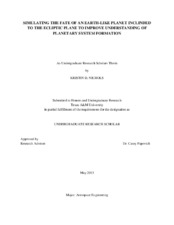| dc.description.abstract | The formation of our Earth and Solar System has befuddled humankind for centuries. Although there remain a number of peculiarities to be remedied by the currently held nebular theory of Solar System formation, there exists a widely held convergence on the basic components of planetary formation.
Interactions with the giant planets of our system, as well as heavy bombardment that occurred billions of years ago, played major roles in early Solar System formation and continue to shape its dynamics through huge gravitational perturbations. In order to better understand the effect that planetary giants have on bodies within our Solar System, this paper proposes to simulate the n-body problem for the Sun-Jupiter-Earth system so as to quantify the effect that a Jupiter giant would have on an Earth-like planet inclined to the ecliptic planet. Through iteration of the Earth-like planet’s inclination, the maximum angle of inclination before ejection from the Solar System can be found.
Using only Newtonian forces for the three-body problem, the simulation runs using a Runge-Kutta 4 solver to plot each body’s position, velocity, and acceleration against time. These results give new insight into why our Solar System lies primarily in the ecliptic disc and how its dynamics will continue to vary over time. For the Sun-Earth-Jupiter system simulated in this paper (run over 119,000 years), orbits inclined to the ecliptic plane greater than 50° became unstable, with Earth ejection after 62,000 years (85°).
Furthermore, simulation of other solar systems leads to a more general theory on the impact of planetary formation and heavy bombardment on the fate of Earth-like planets elsewhere in the Universe. For the exoplanetary system simulated in this paper, which includes a hot Jupiter at 1.5 AU and an Earth-like planet at 1 AU (run over 94,000 years), orbits inclined to the ecliptic plane greater than 10° became unstable, with Earth ejection after 6,250 years (50°). Thus, as the Jupiter giant is moved inward, its influence over the Earth-like planet increases and the time to orbital decay of the Earth-like planet decreases. Overall, these results illustrate that the orbits of Earth-like planets in systems with Jupiter giants have restrictions on available orbital inclinations to remain stable. | en |


